Tower 42
Tower 42 is a 183 metres (600 ft) skyscraper in the City of London. It is the fifth-tallest in the City and fifteenth-tallest in Greater London.[2] Its original name was the National Westminster Tower (commonly known as the NatWest Tower), having been built to house NatWest's international headquarters. Seen from above, the shape of the tower resembles that of the NatWest logo (three chevrons in a hexagonal arrangement).[3]
| Tower 42 | |
|---|---|
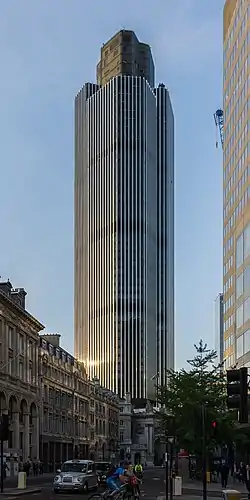 Tower 42 is the fifth-tallest building in the City of London | |
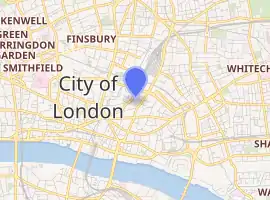
| |
| Former names | NatWest Tower; International Financial Centre |
| Record height | |
| Tallest in the United Kingdom from 1980 to 1991[I] | |
| Preceded by | BT Tower |
| Surpassed by | One Canada Square |
| General information | |
| Type | Commercial |
| Location | London, EC2 |
| Coordinates | 51°30′55″N 0°05′02″W |
| Construction started | 1971 |
| Completed | 1980 |
| Height | |
| Roof | 183 metres (600 ft) |
| Technical details | |
| Floor count | 47 |
| Floor area | 30,100 m2 (324,000 sq ft)[1] |
| Lifts/elevators | 21 |
| Design and construction | |
| Architect | R Seifert & Partners |
| Structural engineer | Pell Frischmann |
| Main contractor | John Mowlem & Co Ltd |
The tower, designed by Richard Seifert and engineered by Pell Frischmann, is located at 25 Old Broad Street in the ward of Cornhill. It was built by John Mowlem & Co between 1971 and 1980, first occupied in 1980, and formally opened on 11 June 1981 by Queen Elizabeth II.[4]
The construction cost was £72 million (approximately £311 million today).[5] It is 183 metres (600 ft) high, which made it the tallest building in the United Kingdom until the topping out of One Canada Square at Canary Wharf in 1990. It was the tallest building to have been built in London in the 1980s. It held the status of tallest building in the City of London for 30 years, until it was surpassed by the Heron Tower in December 2009.
The building today is multi-tenanted and comprises Grade A office space and restaurant facilities, with restaurants on the 24th and 42nd floors.[6] In 2011, it was bought by the South African businessman Nathan Kirsh for £282.5 million.[7]
History
Design and development

The National Westminster Tower's status as the first skyscraper in the city was a coup for NatWest, but was extremely controversial at the time, as it was a major departure from the previous restrictions on tall buildings in London. The original concept dates back to the early 1960s, predating the formation of the National Westminster Bank. The site was then the headquarters of the National Provincial Bank, with offices in Old Broad Street backing onto its flagship branch at 15 Bishopsgate.
Early designs envisaged a tower of 137 metres (449 ft); this developed into a design with a 197-metre (646 ft) tower as its centrepiece, proposed in 1964 by architect Richard Seifert. The plan attracted opposition, partly because of the unprecedented height of the design and partly because of the proposed demolition of the 19th-century bank building at 15 Bishopsgate, which dated from 1865 and was designed by architect John Gibson. Seifert, who had developed a reputation for overcoming planning objections, organised an exhibition in which he presented two alternative visions: his preferred design, and a second design featuring a 500-foot (150 m) tower with an "absurdly squat" second tower alongside. Visitors were invited to vote and overwhelmingly chose the single tower design.[10] The final design preserved the Gibson banking hall and the tower's height was reduced to 183 metres (600 ft).
Construction

Demolition of the site commenced in 1970 and the tower was completed in 1980. The building was constructed by John Mowlem & Co[11] around a huge concrete core from which the floors are cantilevered, giving it great strength but significantly limiting the amount of office space available.
In total, there are 47 levels above ground, of which 42 are cantilevered. The lowest cantilevered floor is designated Level 1, but is in fact the fourth level above ground. The cantilevered floors are designed as three segments, or leaves, which approximately correspond to the three chevrons of the NatWest logo when viewed in plan. The two lowest cantilevered levels (1 and 2) are formed of a single "leaf"; and the next two (3 and 4) are formed of two leaves. This pattern is repeated at the top, so that only levels 5 to 38 extend around the whole of the building.
The limitations of the design were immediately apparent - even though the building opened six years before Big Bang, and so there was less of a requirement for large trading floors, the bank decided not to locate its foreign exchange and money market trading operation ("World Money Centre") in the tower; the unit remained in its existing location at 53 Threadneedle Street. Other international banking units, such as International Westminster Bank's London Branch and the Nostro Reconciliations Department remained at their locations (at 41 Threadneedle Street and Park House, Finsbury Square, respectively) due to lack of space in the tower.
Innovative features in the design included double-decked lifts, which provide an express service between the ground/mezzanine levels and the sky lobbies at levels 23 and 24. Double-decked lifts and sky lobbies were both new to the UK at the time. Other innovative features included an internal automated "mail train" used for mail deliveries and document distribution; an automated external window washing system; and computer controlled air conditioning. The tower also had its own telephone exchange in one of the basement levels – this area was decorated with panoramic photographs of the London skyline, creating the illusion of being above ground.[12]

Fire suppression design features included pressurised stairwells, smoke venting and fire retardant floor barriers. However, at the time of design, fire sprinkler systems were not mandatory in the UK and so were not installed.[12] It was this omission, coupled with a fire in the tower during the 1996 refurbishment, that prompted the Greater London Council to amend its fire regulations and require sprinkler installations at all buildings.[13]
The cantilever is constructed to take advantage of the air rights granted to it and the neighbouring site whilst respecting the banking hall on that adjacent site, as only one building was allowed to be developed. For a time it was the tallest cantilever in the world.
Ownership
Following NatWest's refurbishment of the tower, the bank renamed it the International Finance Centre, in 1997.[14] The building was subsequently acquired by Hermes Real Estate and BlackRock's UK property fund in 1998 for GB£226 million.[15] In 2010 they put the property on the market at an expected price of GB£300 million. This would potentially have been the largest single commercial property sale in the City of London in 2010.[16] In July 2010 it was reported that Chinese Estates Group had entered exclusive discussions to buy Tower 42.[17] but this deal did not conclude and it was sold in 2011 to South African businessman Nathan Kirsh for £282.5 million.[7]
Occupancy
NatWest occupation


Upon completion, the tower was occupied by a large part of NatWest's International Division. The upper floors were occupied by the division's executive management, marketing, and regional offices, moving from various locations in the City of London. The lower floors were occupied by NatWest's Overseas Branch, moving from its previous location at 52/53 Threadneedle Street.
The full floor configuration was as follows:
| Floors | Configuration | Occupants |
|---|---|---|
| unnamed | Core only | Plant floor |
| unnamed | Core only | Plant floor |
| 42 | Core and cantilever (1 leaf) | Viewing Gallery |
| 41 | Core and cantilever (1 leaf) | Corporate hospitality suite |
| 39 – 40 | Core and cantilever (2 leaves) | Corporate hospitality rooms and kitchens |
| 37 – 38 | Core and cantilever (3 leaves) | Executive Management |
| 36 | Core and cantilever (3 leaves) | Planning & Projects; Subsidiaries & Affiliates; Administration |
| 35 | Core and cantilever (3 leaves) | Advances; Marketing & Co-ordination |
| 34 | Core and cantilever (3 leaves) | United Kingdom Region |
| 33 | Core and cantilever (3 leaves) | Corporate Financial Services; staff restaurant |
| 32 | Core and cantilever (3 leaves) | Online Trading Services |
| 31 | Core and cantilever (3 leaves) | Plant floor |
| 29 – 30 | Core and cantilever (3 leaves) | Corporate Financial Services |
| 28 | Core and cantilever (3 leaves) | Asia & Australasia Region |
| 27 | Core and cantilever (3 leaves) | Latin America Region; staff restaurant |
| 26 | Core and cantilever (3 leaves) | Africa & Middle East Region; Eastern Europe & Scandinavia Region |
| 25 | Core and cantilever (3 leaves) | Northern Europe Region; Southern Europe Region |
| 24 | Core and cantilever (3 leaves) | Treasurer's Department; Correspondent Bank Relationships |
| 23 | Core and cantilever (3 leaves) | Financial Control Department |
| 22 | Core and cantilever (3 leaves) | Plant floor |
| 21 | Core and cantilever (3 leaves) | North America Representative Office |
| 20 | Core and cantilever (3 leaves) | Personnel Department |
| 19 | Core and cantilever (3 leaves) | Overseas Branch – Management |
| 14 – 18 | Core and cantilever (3 leaves) | Overseas Branch – International Trade & Banking Services |
| 13 | Core and cantilever (3 leaves) | Plant floor |
| 12 | Core and cantilever (3 leaves) | Mail & Translations |
| 9 – 11 | Core and cantilever (3 leaves) | Overseas Branch – Accounting |
| 8 | Core and cantilever (3 leaves) | Overseas Branch – Payments Abroad |
| 5 – 7 | Core and cantilever (3 leaves) | Overseas Branch – Inland Payments |
| 4 | Core and cantilever (2 leaves) | Staff restaurant |
| 3 | Core and cantilever (2 leaves) | Maintenance, services |
| 1 – 2 | Core and cantilever (1 leaf) | Maintenance, telephony, services |
| Podium | Core and entrance structure | Building control centre |
| Mezzanine | Core and entrance structure | Upper entrance lobby & lifts |
| Ground | Core and entrance structure | Lower entrance lobby & lifts |
The adjacent annexe building at 27 Old Broad Street was occupied by NatWest's Overseas Branch cashiers and foreign notes and coin dealing operation.
1993 bombing and refurbishment
In 1993, NatWest had planned a major premises relocation that would have seen the International Banking Division move from the tower and be replaced with its Domestic Banking Division, enabling the bank to terminate its lease of the Drapers Gardens tower. These plans had to be abandoned after the tower was damaged in the April 1993 Bishopsgate bombing, a Provisional Irish Republican Army truck bombing in the Bishopsgate area of the City of London. The bomb killed one person and extensively damaged the tower and many other buildings in the vicinity, causing a total of over £1 billion worth of damage to the area.[18] The tower suffered severe damage and had to be entirely reclad and internally refurbished at a cost of £75 million.[19] (Demolition was considered, but would have been too difficult and expensive.)[20] The external re-clad was carried out by Alternative Access Logistics with the use of a multi-deck space frame system to access three floors at once with the ability to move up and down the whole building.[21]
On 17 January 1996, during the repairs and possibly from the welding being undertaken, a fire started at the top of the building.[22] Five hundred workmen were evacuated and smoke was seen coming out of the top of the building.[22] A helicopter using thermal imaging equipment pinpointed the source of the fire, which was on the 45th floor in a glass-fibre cooling tower.[22] After refurbishment, NatWest decided not to re-occupy and renamed the building the International Financial Centre, then sold it.
Current occupation
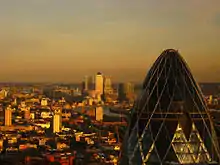
Previous owners, UK property company Greycoat, renamed it Tower 42 in 1995, in reference to its 42 cantilevered floors. It is now a general-purpose office building occupied by a variety of companies.[23]
Current tenants of the building include:
- Adjusting Services International Limited - ASi
- Avaya Technologies
- Boston Technologies, Inc.[24]
- CEBS Secretariat[25]
- City Osteopath Clinics[26]
- Corporate Communications (Europe)[27]
- Coriolis
- Crazy Domains[28]
- Cuatrecasas, Gonçalves Pereira (Lawyers)
- CSJ Capital Partners LLP
- Daewoo Securities (Europe)
- Davis & Co, Solicitors
- EUKOR Car Carriers Inc
- ESecLending
- European Banking Authority
- Fiber Telecom[29]
- Front Capital Systems
- GPQS
- Haarmann Hemmelrath & Partner, Solicitors
- Hong Kong Airlines
- IWG
- Knight Piésold
- Kofax
- Majedie Investments
- Meditor Capital Management
- Momenta Consulting
- Natexis Banques Populaires
- RMG Networks
- Oanda
- Orrick Herrington & Sutcliffe, Legal Services
- Pillsbury Winthrop Shaw Pittman
- Piraeus Bank[30]
- Private Dining 24
- Project Brokers[31]
- R G A (UK)
- City Social (restaurant)
- Samsung
- Sanders Wilkinson Krajcirovic Nikolayev & partners, Legal services
- System Access (Europe)
- Taylor Vinters
- The Walpole Group
- Tower Trading Group
- Tower 42 Property & Estate Management
- Tullett Prebon Information
- Vertigo 42
- ViewSonic
Lighting display
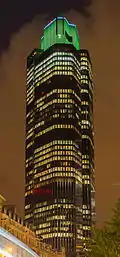
In June 2012, a Capix LED multi-media lighting system was installed around levels 39 to 45. This replaced the previous high-energy floodlighting at the top of the building.[32]
The lighting system is formed of thousands of pixels mounted on a chain netting that is affixed to the surface of the building. Each pixel is formed of three RGB LED units, allowing a variety of lighting designs and colours to be displayed.[33] The system was designed by SVM Associates and Zumtobel.
The display featured the Olympic Rings during the London 2012 Olympic Games and the Paralympic Agitos during the London 2012 Paralympic Games.
Ranking among London high-rise buildings
The National Westminster Tower was the tallest building in London and the United Kingdom for 10 years. At its completion in 1980, it claimed this title from the 175-metre (574 ft) Post Office Tower, a transmission tower located at 60 Cleveland Street in Fitzrovia, London.
Tower 42 is now the third-tallest tower in the City of London, having been overtaken in 2010 by the 230-metre (750 ft) Heron Tower and the 225-metre (738 ft) Leadenhall Building in 2014. It is the eighth-tallest in London overall.[34]
| Records | ||
|---|---|---|
| Preceded by Post Office Tower |
Tallest Building in the United Kingdom 1980—1991 183 m (600 ft) |
Succeeded by One Canada Square |
| Preceded by Post Office Tower |
Tallest Building in London 1980—1991 183 m (600 ft) |
Succeeded by One Canada Square |
| Preceded by Britannic House |
Tallest Building in the City of London 1980—2010 183 m (600 ft) |
Succeeded by Heron Tower |
Previous buildings on the site
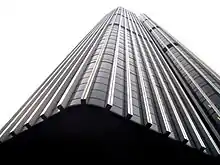
- Gresham House, built in 1563 by Sir Thomas Gresham. Gresham was a businessman who helped set up the Royal Exchange. Upon the death of his wife in 1596, Gresham House became the 'Institute for Physic, Civil Law, Music, Astronomy, Geometry and Rhetoric', as directed by Gresham's will (Sir Thomas died 17 years earlier). Professors at Gresham College, described as the Third University of England by Chief Justice Coke in 1612, included Robert Hooke, Sir Christopher Wren and the composer John Bull. The building survived the Great Fire, and saw use as a garrison, a Guildhall and Royal exchange. The College moved to Gresham Street. Gresham House was demolished in 1768 and a new Gresham House was built in its place.
- Crosby Hall, built in 1466 and named for its builder, the London merchant and alderman, Sir John Crosby. Its most famous occupant was King Richard III. A famous visitor was William Shakespeare. A scene of his play, Richard III, in which the future Richard III, then Duke of Gloucester, plots his route to the crown, is set in Crosby Hall.
- Crosby Place, which was built in 1596, the year that Richard III was written.
- Palmerston House was a building that survived from the 19th century, through both world wars. It was named after the Third Viscount Palmerston. It stood at 51-55 Broad Street. It was occupied for some time by the Cunard Steam Shipping Company.
In popular culture
- The tower, along with other famous London buildings feature in the music video for Tomorrow Comes Today by Gorillaz.
- The tower was the end point of a race on the popular BBC Show Top Gear where the hosts Jeremy Clarkson, Richard Hammond & James May raced each other (Clarkson in a then new Bugatti Veyron and Hammond & May using a combination of a Cessna 182 and various forms of public transport) from Northern Italy to deliver Truffles to the restaurant on floor 42.
See also
Notes
- "Tower 42". Skyscraper Center. CTBUH. Retrieved 18 October 2017.
- "existing | Buildings". Emporis. Retrieved 20 August 2012.
- Hibbert, Christopher; Weinreb, Ben; Keay, John; Keay, Julia (2011). The London Encyclopaedia (3rd ed.). Pan Macmillan. p. 574. ISBN 9780230738782. Retrieved 20 August 2014.
- "Glasgow Herald, June 12, 1981, p1". Retrieved 20 August 2012.
- UK Retail Price Index inflation figures are based on data from Clark, Gregory (2017). "The Annual RPI and Average Earnings for Britain, 1209 to Present (New Series)". MeasuringWorth. Retrieved 2 February 2020.
- "Archived copy". Archived from the original on 9 June 2011. Retrieved 7 February 2016.CS1 maint: archived copy as title (link)
- "South African tycoon Nathan Kirsh buys Tower 42" Daily Telegraph 21 December 2011 Retrieved 21 December 2011
- "The Notorious Work of Richard Seifert". building.co.uk. Retrieved 21 August 2014. (subscription required)
- London's Growing Up!: NLA Insight Study (PDF). NLA — London’s Centre for the Built Environment. 2014. p. 44. ISBN 978-0-9927189-1-6. Archived from the original (PDF) on 21 August 2014. Retrieved 21 August 2014.
- "Richard Seifert". The Daily Telegraph. London. 29 October 2001.
- Mowlem dives into the red Evening Standard, 4 February 2005
- "Building innovation reaches the sky", New Scientist, 18 January 1979
- "Tower 42 and Section 20 London Building Act", Gary Fells, Scott White and Hookins Press Release, 29 June 2010
- "NatWest could sell tower". The Independent. 23 March 1998. Retrieved 20 August 2014.
- Goodway, Nick (15 April 2010). "Outdated and second best, its time for the fall of Tower 42". Evening Standard. Retrieved 20 August 2014.
- "Tower 42 skyscraper on market for £300m - Business - Evening Standard". Thisislondon.co.uk. 13 April 2010. Archived from the original on 5 June 2011. Retrieved 20 August 2012.
- Marion Dakers (5 July 2010). "Chinese firm in exclusive talks to acquire Tower 42 | City A.M". City A.M. Retrieved 20 August 2012.
- De Baróid, Ciarán (2000). Ballymurphy and the Irish War. Pluto Press. p. 325. ISBN 0-7453-1509-7.
- Nick Goodway (15 April 2010). "Outdated and second best, its time for the fall of Tower 42 - Analysis & Features - Business - Evening Standard". Standard.co.uk. Retrieved 20 August 2012.
- Terminal Architecture, page 59, Martin Pawley, 1998, Reaktion Books (ISBN 1861890184)
- "The Natwest Tower, London - Multi-deck space frame system". Alternative Access Logistics Ltd. Archived from the original on 8 July 2011. Retrieved 16 April 2010.
- "500 workmen escape NatWest Tower blaze", The Independent, 18 January 1996. Retrieved 19 September 2010
- "Shops on Old Broad Street, EC2N". London Online. Retrieved 16 April 2010.
- "Boston Technologies website". Bostontechnologies.com. Archived from the original on 15 June 2012. Retrieved 20 August 2012.
- "CEBS Secretariat Offices London - Handbook for visitors" (PDF). Committee of European Banking Supervisors. p. 2. Retrieved 16 April 2010.
- "City Osteopath Clinics". Cylex-uk.co.uk. Retrieved 20 August 2012.
- "Corporate Communications - Contact". Corporate Communications (Europe) Limited. Archived from the original on 10 April 2010. Retrieved 16 April 2010.
- "Crazy Domains contact us". Crazydomains.co.uk. Retrieved 29 January 2018.
- "Fiber Telecom Ltd". Fibtel.net. Retrieved 30 July 2019.
- "Piraeus Bank website". Piraeusbank.co.uk. Retrieved 20 August 2012.
- "Project Brokers website". Projectbrokers.com. Retrieved 20 August 2012.
- "Archived copy". Archived from the original on 11 October 2012. Retrieved 25 September 2012.CS1 maint: archived copy as title (link)
- http://www.zumtobel.com/PDB//PDB/Ressource/teaser/EN/Capix.pdf
- "Home | CTBUH Skyscraper Center". Buildingdb.ctbuh.org. Retrieved 20 August 2012.
- "Vertical Rush". shelter.org.uk.
- Hollingshead, Iain (21 February 2011). "Could you run a vertical marathon?". The Daily Telegraph.
External links
| Wikimedia Commons has media related to Tower 42. |
- Official website
- The Tower 42 Bird Study Group, which aims to study the migration of large birds of prey and other bird species over London seen from the roof during the spring (April - June) and autumn (August - November)
- Tower 42 at Structurae


